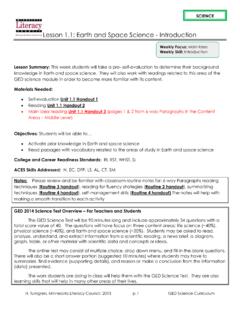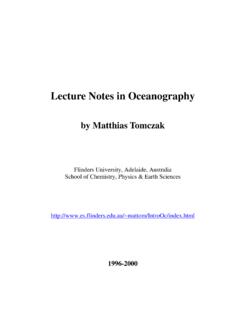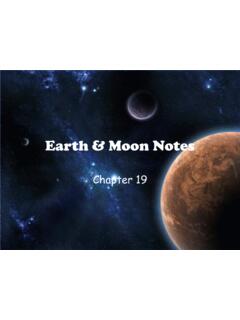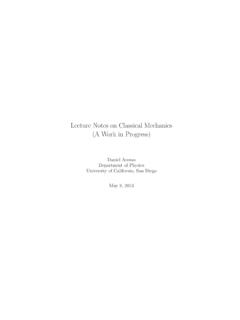Transcription of Earth Science - NASA
1 Enterprise: Earth Science THEMES. Earth System Science Earth Science Applications Seeing Earth through the lens of Science : This Earth image is a compilation of several data sets of the type produced by NASA's Earth Observing System, including cloud cover, vegetation, fires, and sea surface temperature. From the latter, the 1997-98 El Ni o is clearly visible. Earth Science . PURPOSE. The mission of NASA's Earth Science Enterprise (ESE) is to develop a scientific understanding of the Earth system and its response to natural and human-induced changes. This understanding enables us to improve prediction of climate, weather, and natural hazards.
2 NASA brings to this endeavor the unique vantage point of space, allowing global views of Earth system change. NASA is a provider of scientific information via observation, research, modeling, and integrated solutions to meet national priorities. NASA has been studying Earth from space from its beginnings as an Agency. NASA. research and development of aerospace Science and technology has resulted in deployment of the first series of Earth Observing System (EOS) satellites, which deliver observations of the major interactions of the land, oceans, atmosphere, ice, and life that comprise the Earth system.
3 In short, the purpose of the ESE is to provide scientific answers to the fundamental question: How is Earth changing and what are the consequences for life on Earth ? ESA 8-1. Enterprise: Earth Science FY 2003 ACCOMPLISHMENTS. NASA's Solar Radiation and Climate Experiment (SORCE) was successfully launched in January 2003. SORCE is studying the Sun's influence on Earth and will measure how the Sun affects the Earth 's ozone layer, atmospheric circulation, clouds, and oceans. The NASA-sponsored Gravity Recovery and Climate Experiment (GRACE) mission produced the most accurate map ever created of Earth 's gravity field.
4 Using 111 days of satellite data, the GRACE Science team generated a model of the Earth 's gravity field that is up to 100 times more accurate than the previous model, which was constructed from decades of geodetic data. These precise gravity maps, and resulting geoid models, facilitate investigations into the time-variable distribution of the Earth 's mass and the structure of tectonic features, such as deep ocean trenches. Also, precise gravity data are improving satellite altimetry observations of sea surface height and ocean circulation, contributing to improved predictions of weather and climate change.
5 New evidence from NASA Earth observation systems and Earth Science models reveals how urban areas, with their asphalt, buildings, and aerosols, are impacting local and possibly global climate processes. To study urban impact on local rainfall, NASA and university scientists used the world's first space-based rain radar system, aboard NASA's TRMM. satellite, and a dense network of in-situ rain gauges to determine that there are higher rainfall rates during the summer months downwind of large cities like Houston and Atlanta. These results offer new evidence that rainfall patterns and daily precipitation trends have changed in regions downwind of Houston from a period of pre-urban growth, 1940 to 1958, to a post-urban growth period, 1984 to 1999.
6 Warming from urban heat islands, the varied heights of urban structures that alter winds, and interactions with sea breezes are believed to be the primary causes for the findings in a coastal city like Houston. NASA launched the Ice, Cloud, and Land Elevation Satellite (ICESat) in January 2003 to quantify ice sheet growth (or retreat) and help answer questions concerning many related aspects of the Earth 's climate system, including global climate and sea level changes. The global perspective and frequent polar coverage of Earth observation satellites have enabled comprehensive studies of how polar regions are changing, providing insight into their interactions with the rest of the climate system.
7 In 2003, a NASA-led research team reported significant changes in sea ice distribution accompanying warming over much of the Arctic by as much as 4 F in the 1980s and 1990s. Not only has the aerial extent of sea ice coverage in the Arctic decreased by about three percent per decade in the last 24 years, but more notably, the extent of the older and thicker perennial sea ice has decreased by nearly ten percent per decade. Sea ice changes in the Antarctic have been much less than those in the Arctic, and while the extent of Antarctic sea ice has been decreasing over the last three decades, total Antarctic ice has actually increased slightly in the last 20 years.
8 NASA's Landsat 7 and Terra satellites also showed large floating ice shelves breaking away from Antarctica's coastal regions, and the motion of ice in "ice streams" and outlet glaciers has accelerated as a result. NASA measurements, mainly from the Terra, Aqua, Tropical Rainfall Measuring Mission (TRMM), and Total Ozone Mapping Spectromoter (TOMS) satellites and the AERONET surface network, are contributing to the first global assessment of the aerosol direct radiative effects and the time dependence and strength of the main aerosol sources around the world. The influence of aerosols on air quality and human and ecosystem health is well documented, but large uncertainties exist about the net impact and the diverse warming and cooling influences of the very complex mixture of aerosol types and their spatial distribution within the atmosphere.
9 Researchers at NASA and the Environmental Protection Agency (EPA) developed a data fusion of the NASA observations from the Moderate Resolution Imaging Spectrometer (MODIS) sensors on Terra and Aqua with the EPA in-situ monitoring network as a tool to assist air quality forecasters in assessing particulate pollution and aerosol transport. Forecasters use a three-day visualization of this data fusion to assess transport of aerosols into their region and develop the air quality forecasts issued throughout the United States. A NASA-DoE jointly funded study published in the June 2003 issue of Science showed that patterns of primary productivity of plants on land and phytoplankton in the ocean are changing in ways linked to changes in climate.
10 New analyses of observations from several Earth observation satellites from the 1980s to the present have documented a net increase in primary productivity of six percent over the past 18 years, with 25 percent of the global land area showing significant increases and seven percent showing significant decreases. Ecosystems in all tropical regions and in the high latitudes of the Northern Hemisphere accounted for most of the increase. The tropical increases were attributed to decreased cloud cover and the resulting increase in solar radiation. Increases in other regions were due to the combined effects of increasing temperature, changes in rainfall, and changes in solar radiation.



















